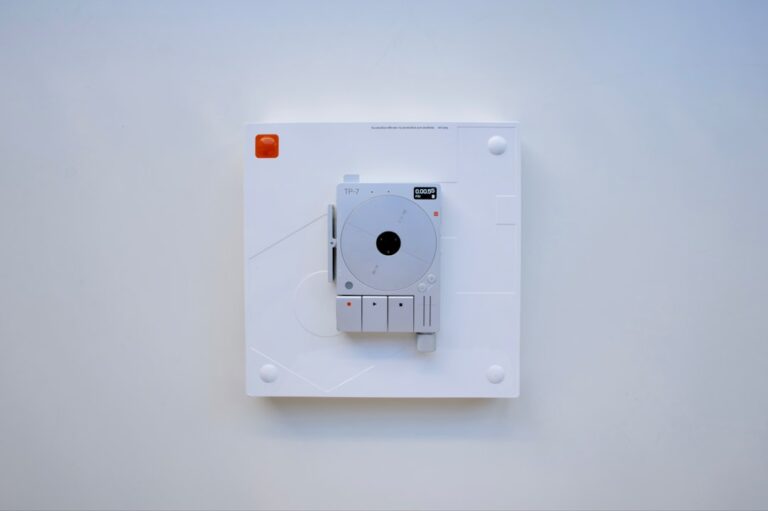Smart thermostats represent a significant advancement in home climate control technology. Unlike traditional thermostats, which require manual adjustments to regulate temperature, smart thermostats utilize Wi-Fi connectivity and advanced algorithms to learn user preferences and optimize heating and cooling schedules. These devices can be controlled remotely via smartphones or tablets, allowing homeowners to adjust their home’s temperature from virtually anywhere.
The integration of sensors and machine learning enables these thermostats to adapt to the habits of the household, ensuring comfort while maximizing energy efficiency. The evolution of smart thermostats has been driven by the increasing demand for energy-efficient solutions in residential settings. As homeowners become more conscious of their environmental impact and energy consumption, smart thermostats have emerged as a practical solution.
They not only provide convenience but also contribute to sustainability efforts by reducing energy waste. With features such as geofencing, which detects when residents are away from home, smart thermostats can automatically adjust settings to save energy without sacrificing comfort.
Key Takeaways
- Smart thermostats help you control your home’s temperature remotely and save energy
- Installing a smart thermostat can lead to lower utility bills and increased comfort
- Consider factors like compatibility, features, and budget when choosing a smart thermostat
- Prepare your home by checking compatibility, Wi-Fi strength, and power source for the smart thermostat
- Hiring a professional ensures proper installation and integration with other smart home devices
Benefits of Smart Thermostat Installation
The installation of a smart thermostat offers numerous benefits that extend beyond mere convenience. One of the most significant advantages is the potential for substantial energy savings. By optimizing heating and cooling schedules based on real-time data and user behavior, smart thermostats can significantly reduce energy consumption.
Homeowners often report savings of up to 20% on their heating and cooling bills after installing these devices, making them a financially sound investment in the long run. In addition to cost savings, smart thermostats enhance the overall comfort of a home. They can create personalized heating and cooling schedules tailored to the preferences of each household member.
For instance, if a family prefers a cooler environment at night and a warmer one during the day, the smart thermostat can be programmed to accommodate these preferences seamlessly. Furthermore, many models come equipped with features such as humidity control and air quality monitoring, ensuring that the indoor environment remains healthy and comfortable.
Choosing the Right Smart Thermostat for Your Home
Selecting the ideal smart thermostat for a home involves considering various factors, including compatibility with existing HVAC systems, user interface preferences, and specific features that cater to individual needs. Homeowners should first assess whether their current heating and cooling systems are compatible with smart technology. Most modern HVAC systems work well with smart thermostats, but older systems may require additional adapters or may not be compatible at all.
Another critical aspect to consider is the user interface and ease of use. Some smart thermostats feature touchscreens with intuitive navigation, while others may rely on mobile apps for control. Homeowners should choose a model that aligns with their comfort level regarding technology.
Additionally, features such as voice control compatibility with virtual assistants like Amazon Alexa or Google Assistant can enhance usability and convenience, making it easier for users to adjust settings hands-free.
Preparing Your Home for Smart Thermostat Installation
| Area | Metrics |
|---|---|
| Thermostat Compatibility | Check if your current HVAC system is compatible with the smart thermostat |
| Wi-Fi Connection | Ensure a stable Wi-Fi connection for the smart thermostat to function properly |
| Power Source | Determine if the smart thermostat requires a C-wire or if it can be powered by batteries |
| Location | Choose an optimal location for the smart thermostat for accurate temperature readings |
| Compatibility with Smart Home Systems | Check if the smart thermostat is compatible with your existing smart home system |
Before installing a smart thermostat, homeowners should take several preparatory steps to ensure a smooth installation process. First, it is essential to gather all necessary tools and materials, which may include screwdrivers, a level, and wire labels. Additionally, homeowners should turn off the power to their HVAC system at the circuit breaker to ensure safety during installation.
Next, it is advisable to take note of the existing thermostat’s wiring configuration. This can be done by carefully removing the old thermostat and labeling each wire according to its corresponding terminal. This step is crucial for ensuring that the new smart thermostat is wired correctly, preventing potential issues during operation.
Homeowners should also clean the wall surface where the new thermostat will be mounted, ensuring a secure fit and an aesthetically pleasing appearance.
Hiring a Professional for Smart Thermostat Installation
While many homeowners may feel confident in their ability to install a smart thermostat themselves, hiring a professional can provide peace of mind and ensure optimal performance. Professional installers possess the expertise needed to navigate any complexities that may arise during installation, particularly in homes with older or unconventional HVAC systems. They can also provide valuable insights into selecting the right model based on specific home requirements.
Moreover, professional installation often comes with warranties or guarantees that cover any potential issues that may occur post-installation. This added layer of protection can be particularly beneficial for homeowners who are unfamiliar with electrical work or those who simply prefer to leave such tasks to experts. Ultimately, investing in professional installation can save time and reduce the risk of costly mistakes.
Setting Up and Programming Your Smart Thermostat
Once installed, setting up and programming a smart thermostat is typically straightforward, thanks to user-friendly interfaces and guided setup processes. Most models require users to connect the device to their home Wi-Fi network, which allows for remote access via mobile apps. After establishing a connection, users can begin customizing their thermostat settings according to their preferences.
Programming options vary by model but generally include creating heating and cooling schedules based on daily routines. For instance, homeowners can set different temperatures for weekdays versus weekends or program specific temperatures for when they are at home versus when they are away. Many smart thermostats also offer learning capabilities that allow them to automatically adjust settings based on user behavior over time, further enhancing convenience and energy efficiency.
Integrating Your Smart Thermostat with Other Smart Home Devices
One of the standout features of smart thermostats is their ability to integrate seamlessly with other smart home devices. This interconnectedness allows homeowners to create a cohesive smart home ecosystem that enhances convenience and efficiency. For example, when paired with smart lighting systems, a smart thermostat can adjust heating or cooling based on whether rooms are occupied or unoccupied.
Additionally, integration with security systems can provide added benefits; for instance, if a security camera detects that no one is home, the thermostat can automatically adjust settings to save energy. Voice-activated assistants like Amazon Alexa or Google Assistant can also control smart thermostats through simple voice commands, making it easier for users to manage their home environment without needing to interact directly with their devices.
Monitoring and Controlling Your Home’s Temperature Remotely
One of the most appealing aspects of smart thermostats is the ability to monitor and control home temperatures remotely through mobile applications. This feature provides homeowners with unparalleled flexibility and control over their indoor climate. Whether at work, on vacation, or simply out running errands, users can check their home’s temperature in real-time and make adjustments as needed.
Remote access also allows homeowners to receive alerts about unusual temperature fluctuations or system malfunctions. For instance, if a home’s temperature rises unexpectedly due to a malfunctioning HVAC system, users can be notified immediately via their smartphone app. This capability not only enhances comfort but also helps prevent potential damage caused by extreme temperatures.
Saving Energy and Lowering Utility Bills with a Smart Thermostat
The financial benefits of installing a smart thermostat are significant and well-documented. By optimizing heating and cooling schedules based on real-time data and user habits, these devices can lead to substantial reductions in energy consumption. Homeowners often find that they can lower their utility bills by as much as 20% after making the switch from traditional thermostats.
In addition to immediate savings on monthly bills, smart thermostats contribute to long-term financial benefits by extending the lifespan of HVAC systems. By preventing overuse and ensuring that systems operate efficiently, these devices help reduce wear and tear on heating and cooling equipment. This not only saves money on repairs but also delays the need for costly replacements.
Troubleshooting and Maintenance Tips for Smart Thermostats
While smart thermostats are designed for reliability, occasional issues may arise that require troubleshooting. Common problems include connectivity issues with Wi-Fi networks or incorrect temperature readings due to sensor malfunctions. Homeowners should familiarize themselves with basic troubleshooting steps outlined in the user manual or online resources provided by manufacturers.
Regular maintenance is also essential for ensuring optimal performance of smart thermostats. This includes checking for software updates that may enhance functionality or security features. Additionally, homeowners should periodically clean any dust or debris from sensors and ensure that wiring connections remain secure.
By taking these proactive measures, users can extend the lifespan of their devices while maintaining efficient operation.
Upgrading Your Home’s Technology with Smart Thermostat Installation
The installation of a smart thermostat is not just an upgrade in climate control; it represents a broader shift towards modernizing home technology. As more households embrace smart home solutions, integrating devices like smart thermostats becomes an essential step in creating an efficient living environment. This upgrade not only enhances comfort but also aligns with contemporary trends in sustainability and energy conservation.
Moreover, as technology continues to evolve, homeowners who invest in smart thermostats position themselves at the forefront of innovation in home automation. The ability to integrate various devices into a cohesive system opens up endless possibilities for enhancing daily life through convenience and efficiency. Ultimately, upgrading to a smart thermostat is not merely about temperature control; it is about embracing a smarter way of living that prioritizes comfort, efficiency, and sustainability in an increasingly connected world.
FAQs
What is a smart thermostat?
A smart thermostat is a device that can be connected to a home’s heating and cooling system to control and regulate the temperature remotely using a smartphone or other internet-connected device.
Why should I install a smart thermostat?
Installing a smart thermostat can help you save energy and reduce your heating and cooling costs. It also offers convenience and flexibility in controlling your home’s temperature remotely.
How do I install a smart thermostat?
The installation process for a smart thermostat may vary depending on the model and your home’s heating and cooling system. It typically involves turning off the power to the HVAC system, removing the old thermostat, and connecting the wires to the new smart thermostat according to the manufacturer’s instructions.
Do I need professional help to install a smart thermostat?
While some homeowners may be able to install a smart thermostat themselves, it is recommended to seek professional help, especially if you are not familiar with electrical wiring or HVAC systems. Professional installation can ensure that the thermostat is installed correctly and safely.
What are the benefits of a smart thermostat?
Some benefits of a smart thermostat include energy savings, remote temperature control, personalized heating and cooling schedules, and the ability to monitor and track energy usage.
Are there any rebates or incentives for installing a smart thermostat?
Many utility companies and government agencies offer rebates or incentives for installing a smart thermostat as part of energy efficiency programs. It’s recommended to check with your local utility provider for any available incentives.






